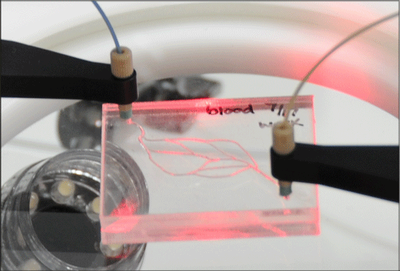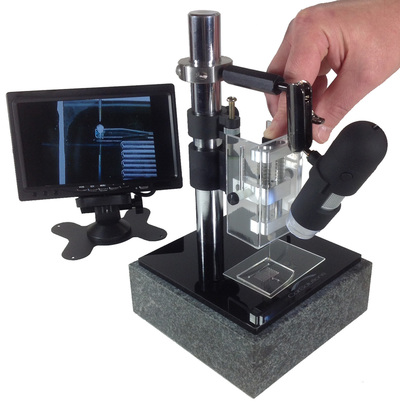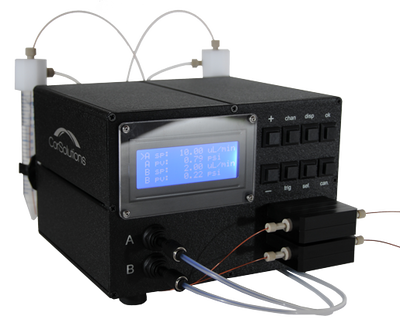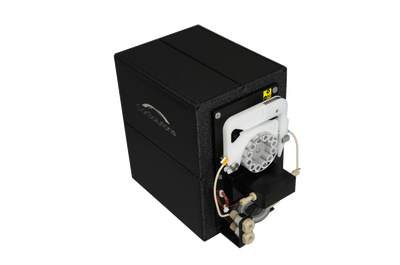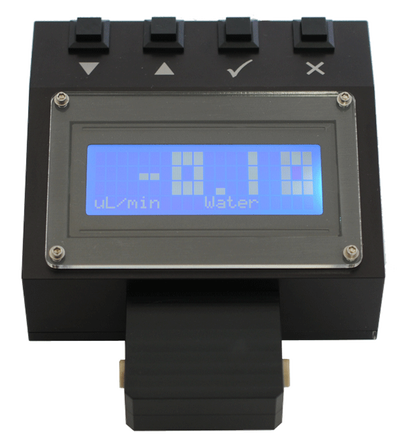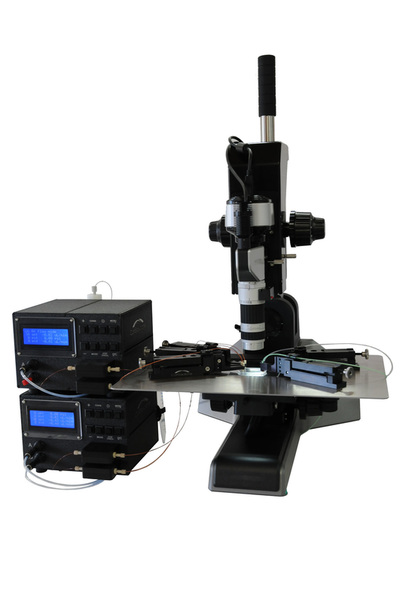Fabricating Microfluidic Devices from PDMS
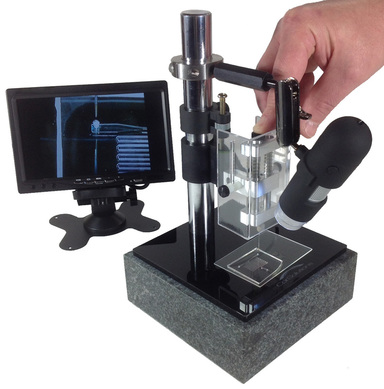 Align the PDMS microdevice in the PDMS Port Creator and then easily create inlet and outlet ports.
Align the PDMS microdevice in the PDMS Port Creator and then easily create inlet and outlet ports.
Polydimethylsiloxane (PDMS) is a silicon-based organic polymer that is widely used for microfluidic devices because it is easy to work with, biocompatible, economical and transparent down to 280 nm. As an elastomer with favorable mold-release properties, the ability to replicate features down to the nanoscale, and with low shrinkage during cure, PDMS can be used to fabricate a myriad of structures through soft lithography. The process of soft lithography consists of creating an elastic stamp which enables the transfer of patterns only a few nanometers in size. Furthermore a single master mold can be used to fabricate numerous PDMS devices.
The process of fabricating a microfluidic device from PDMS is relatively simple. To start, the PDMS two-part kit, consisting of the base and the cross-linking agent are mixed. The mixing ratios and curing procedures used determine the mechanical, chemical and optical properties of the final device. Upon mixing, the PDMS must be degassed under vacuum. Next the liquid pre-polymer is poured over a previously fabricated master mold. The master molds used to fabricate PDMS devices are most commonly made from SU-8. However metal, plastic and even 3D printed maters are now gaining popularity. Once the PDMS is poured into the mold, the liquid pre-polymer conforms to the shape of the mold, replicating the features. Device thickness is controlled by using appropriate spacers, and the PDMS is cured in an oven at 65°C for 24 hours. After curing, the PDMS device is peeled from the master mold and cut as desired. If the device does not release easily, silanization of the mold may be required.
Next the inlet and outlet ports on the device need to be fabricated. To do this, a punch head having the desired cutting diameter is installed in the CorSolutions PDMS Port Creator. Then the device is placed on the Port Creator and aligned to the punch head. The punch is next extended into the device, and upon retraction, a port with smooth edges and no PDMS remnants, is made. This process is repeated until all the desired inlet and outlet ports are fabricated.
The process of fabricating a microfluidic device from PDMS is relatively simple. To start, the PDMS two-part kit, consisting of the base and the cross-linking agent are mixed. The mixing ratios and curing procedures used determine the mechanical, chemical and optical properties of the final device. Upon mixing, the PDMS must be degassed under vacuum. Next the liquid pre-polymer is poured over a previously fabricated master mold. The master molds used to fabricate PDMS devices are most commonly made from SU-8. However metal, plastic and even 3D printed maters are now gaining popularity. Once the PDMS is poured into the mold, the liquid pre-polymer conforms to the shape of the mold, replicating the features. Device thickness is controlled by using appropriate spacers, and the PDMS is cured in an oven at 65°C for 24 hours. After curing, the PDMS device is peeled from the master mold and cut as desired. If the device does not release easily, silanization of the mold may be required.
Next the inlet and outlet ports on the device need to be fabricated. To do this, a punch head having the desired cutting diameter is installed in the CorSolutions PDMS Port Creator. Then the device is placed on the Port Creator and aligned to the punch head. The punch is next extended into the device, and upon retraction, a port with smooth edges and no PDMS remnants, is made. This process is repeated until all the desired inlet and outlet ports are fabricated.
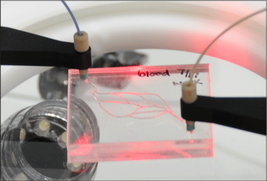 Non-permanent, leak-tight connections are easily made to PDMS microdevices.
Non-permanent, leak-tight connections are easily made to PDMS microdevices.
To add structure to the PDMS microfluidic device, it is desirable to bond the device against a glass, silicon or other PDMS layer. However, as PDMS is strongly hydrophobic with an overall non-reactive surface, it is unable to adhere to any other surface without pre-treatment. By exposing the surface of the device that is to be bonded, to an oxygen plasma for several minutes, the PDMS surface becomes hydrophilic and reactive. Then irreversible bonding can be achieved when the PDMS device encounters the silicon, glass or other PDMS layer that was exposed to the same plasma. This bonding step should be made immediately following plasma exposure as the PDMS surface will return to its original hydrophobic state. In contrast, reversible seals using adhesive tapes are also possible, though these can only be used at low pressures.
Finally to interface the PDMS microdevice with fluid delivery pumps and detectors, CorSolutions compression connectors can be quickly and non-permanently placed over the inlet and outlet ports to make leak-tight connections. These compression seals hold more pressure than simply inserting a tube in a port, which relies solely on the tube stiction.
Finally to interface the PDMS microdevice with fluid delivery pumps and detectors, CorSolutions compression connectors can be quickly and non-permanently placed over the inlet and outlet ports to make leak-tight connections. These compression seals hold more pressure than simply inserting a tube in a port, which relies solely on the tube stiction.

